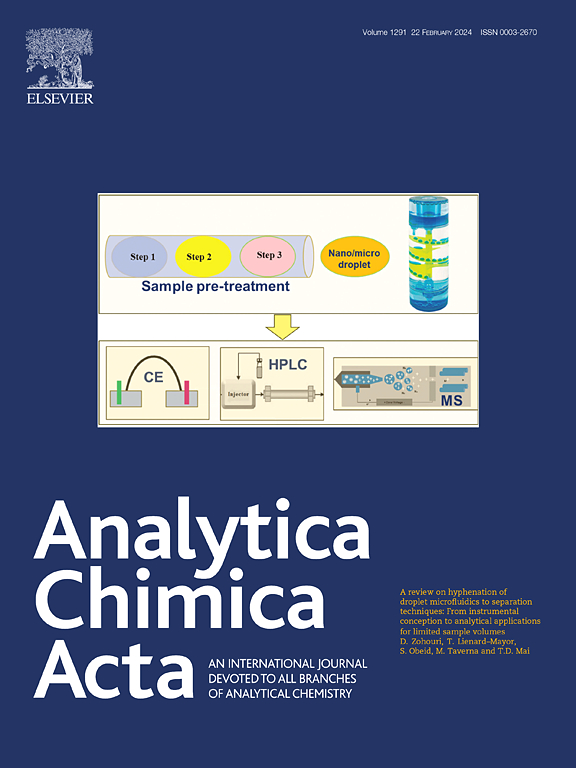Innovative UAPLE system coupled with UV–vis detection: a sustainable method for extracting and quantifying phenolics from rosemary
IF 6
2区 化学
Q1 CHEMISTRY, ANALYTICAL
引用次数: 0
Abstract
Background
Monitoring industrial processes is critical for ensuring consistent product quality, as consumers expect uniformity across different production batches. In the case of herbal extracts, such as rosemary hydroalcoholic extracts, it is essential to control the yield of target compounds to maintain both the expected quality and safety. Typically, these extracts are produced in an extractor and then analyzed separately in a laboratory (offline). By integrating these methods, it is possible to reduce the number of manipulation steps, shorten processing times, and lower solvent and energy consumption; however, combining extraction techniques with quantification analysis remains a challenge.
Results
Accordingly, we designed an innovative method to simultaneously extract and quantify the primary phenolic acids from rosemary using an ultrasound-assisted pressurized liquid extraction (UAPLE) system inline coupled to a UV–vis detector. Jacket temperature (40, 60, 80, 100 °C), nominal power (240, 320, 400 W), and ultrasound time (1, 3, 5 min) were optimized concerning the offline yield of carnosic derivatives (CD) in ethanol 99.5 % (v/v) and rosmarinic acid (RA) in ethanol 30.0 % (v/v). Time and power had minimal impact on the yield of both CD and RA compounds. Temperature was the most significant factor. Increasing temperature favored RA extraction but reduced CD yields above 62.1 °C. Offline optimization yielded 22.7 ± 0.7 mgCD.gbiomass−1 (at 62.1 °C, 400 W, 5 min) and 9.9 ± 0.2 mgRA.gbiomass−1 (at 100 °C, 240 W, 5 min). In addition, changing solvents during the ongoing process allowed to obtain CD and RA in separated fractions.
Significance
This work introduced a green, novel, inline method for selectively UAPLE extracting and quantifying the primary phenolic acids in rosemary. Inline quantification approach successfully matched the offline (conventional) yield for carnosic derivatives and rosmarinic acid. Therefore, our system enabled a quicker and easier quantification of target compounds without compromising the yields.


创新uapple系统与紫外可见检测相结合:一种可持续提取和定量迷迭香酚类物质的方法
监控工业过程对于确保一致的产品质量至关重要,因为消费者期望不同生产批次的一致性。对于草药提取物,如迷迭香水醇提取物,控制目标化合物的产量以保持预期的质量和安全性是至关重要的。通常,这些提取物在提取器中产生,然后在实验室(离线)单独分析。通过整合这些方法,可以减少操作步骤的数量,缩短处理时间,降低溶剂和能源消耗;然而,将提取技术与定量分析相结合仍然是一个挑战。结果基于此,我们设计了一种创新的方法,利用超声辅助加压液体萃取(uapple)系统与紫外可见检测器联联,同时提取和定量迷迭香中的初级酚酸。对夹套温度(40、60、80、100℃)、标称功率(240、320、400 W)和超声时间(1,3,5 min)进行优化,以确定在99.5% (v/v)乙醇条件下鼠目草衍生物(CD)和30.0% (v/v)乙醇条件下迷迭香酸(RA)的脱机产率。时间和功率对CD和RA化合物的产率影响最小。温度是最重要的因素。在62.1℃以上,温度升高有利于RA的提取,但CD的收率降低。离线优化产率为22.7±0.7 mgCD。gbiomass-1(62.1°C, 400 W, 5 min)和9.9±0.2 mgRA。gbiomass-1(在100°C, 240 W, 5分钟)。此外,在进行过程中改变溶剂可以获得分离馏分中的CD和RA。本研究建立了一种绿色、新颖、在线的uapple选择性提取和定量迷迭香中伯酚酸的方法。在线定量方法成功地匹配离线(传统)产率鼠尾草衍生物和迷迭香酸。因此,我们的系统能够在不影响产率的情况下更快,更容易地定量目标化合物。
本文章由计算机程序翻译,如有差异,请以英文原文为准。
求助全文
约1分钟内获得全文
求助全文
来源期刊

Analytica Chimica Acta
化学-分析化学
CiteScore
10.40
自引率
6.50%
发文量
1081
审稿时长
38 days
期刊介绍:
Analytica Chimica Acta has an open access mirror journal Analytica Chimica Acta: X, sharing the same aims and scope, editorial team, submission system and rigorous peer review.
Analytica Chimica Acta provides a forum for the rapid publication of original research, and critical, comprehensive reviews dealing with all aspects of fundamental and applied modern analytical chemistry. The journal welcomes the submission of research papers which report studies concerning the development of new and significant analytical methodologies. In determining the suitability of submitted articles for publication, particular scrutiny will be placed on the degree of novelty and impact of the research and the extent to which it adds to the existing body of knowledge in analytical chemistry.
 求助内容:
求助内容: 应助结果提醒方式:
应助结果提醒方式:


